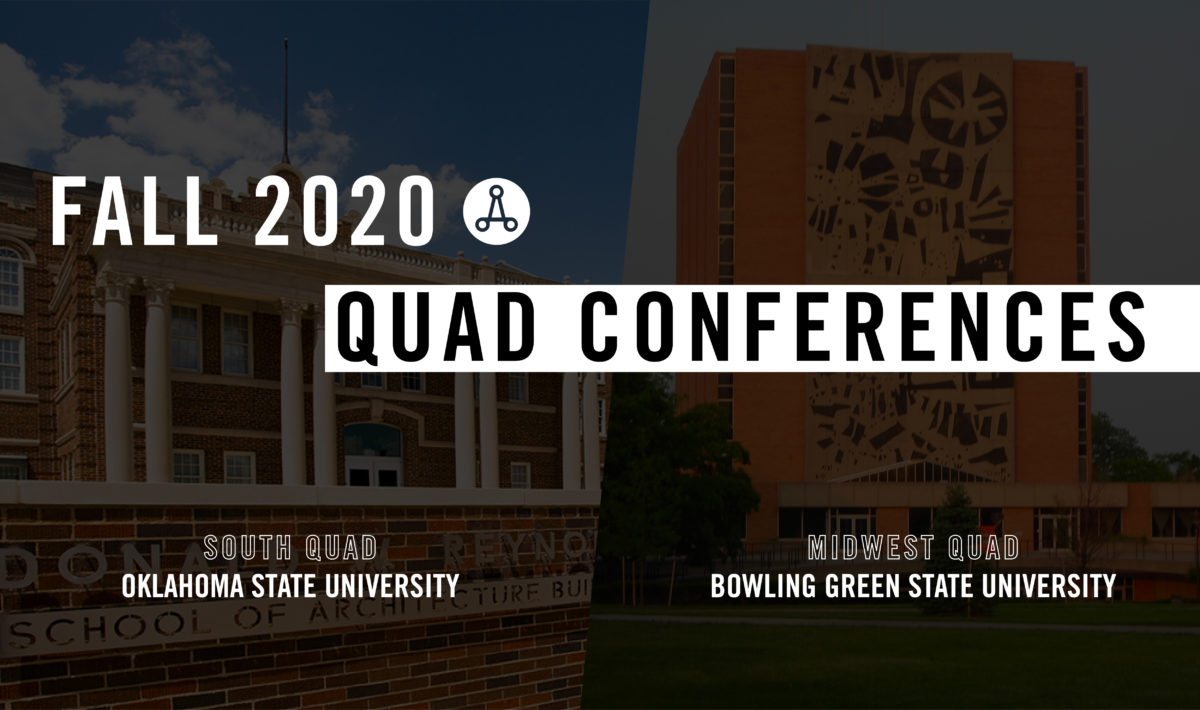Returning in the fall of 2020, regional conferences will take place in the South and Midwest Quads. These gatherings, known as Quad Conferences, are hosted by local chapters who have been selected to organize the event by their Quad at Grassroots! Themes vary based on the city, local culture, and architectural topic of choice.
Quad Conferences are a terrific way to meet other students in your region, learn about architecture outside of the classrooms and engage with professionals. This past year at AIAS FORUM in Toronto, the following schools won the bid to host their Quad’s conference. Each one of these conferences has its own unique identity and schedule. Take a look at the conference descriptions of each quad below:
South Quad Conference
Location: Stillwater, OK
Host School: Oklahoma State University
Dates: November 5th-8th
BREAK THE:
Architecture has many different backgrounds and identities. It is not all conceived in the urban environments. The state of Oklahoma is considered a rural area having only two major cities, Tulsa and Oklahoma City. Oklahoma State University is in Stillwater, Ok with roughly less than 50,000 residents. Considerably a small town, we want to share with our Quad how architecture behaves in a rural setting.
Definition
We are redefining rural and showing how the rural environment has changed throughout the years. What does it mean truly mean to be rural? Focusing on how designers can create architecture in areas that have a lower GDP and smaller population sizes. Looking at how the expansion of cities such as Oklahoma City and Tulsa have impacted smaller communities and why some continue to thrive and others dwindle.
Mold
Here at Oklahoma State University we work very closely with other disciplines within the design community. Our school of architecture houses both Architecture and Architecture Engineering students, studying side-by-side for their first two years in studio. Some studios have teamed with Landscape Architecture students in order to create more holistic projects. Therefore, we want to show the relationships that will be made in the workforce and how we work together. We also want to showcase the other paths outside of licensure that an architecture degree can help a student achieve and expand on the licensure process.
Expectations
Everything has started from somewhere. We want to go back in time, go against the technological world that architecture has come to and showcase the foundations of history that has led us to where we are. We then want to show how the world of architecture is expanding as technology’s abilities grow. how can we as designers maximize the power of technology to design for communities? How will this new age change the way in which we perceive architecture?
Midwest Quad Conference
Location: Bowling Green, OH
Host School: Bowling Green State University
Dates: TBD
REVITALIZE
The “Rust Belt” refers to a region within the Midwest that faced a rapid decline in what used to be known as the Manufacturing Heartland. Because of economic decline, industry rapidly left the Midwest and their booming cities. This caused population to decrease and communities to become bare.
While the “Rust Belt” and decline of industry started around 1980, today there are still cities that suffer from the loss created in this era. Because of this many cities face an increase in crime, abandoned spaces, and are in need of revitalization.
The solution to the problem presented by the “Rust Belt” across the Midwest is architecture. Architecture can use design, knowledge on the environment, and an understanding on civic issues to Revitalize the Midwest and create vibrant communities once again!
Design
Through design, fabrication, and collaboration architects and future architects can use these tools to reuse and adapt cities that have crumbled due to the fall of industrialization.
Environment
While the industrial era of the Midwest had an impact on the environment, now is our opportunity to investigate creative ways to help the environment through the building and architecture industry. Through methods of adaptive reuse, recycling and power of natural resources, the exploration of the connection between the environment and the rust belt can further our design solutions.
Civic
Society was heavily impacted by the dying industrial field in the Midwest. As industrialization fell, communities became unsafe and damaged. Through the solutions created by design and an understanding of the environment communities can be revitalized into desirable and beloved areas.










